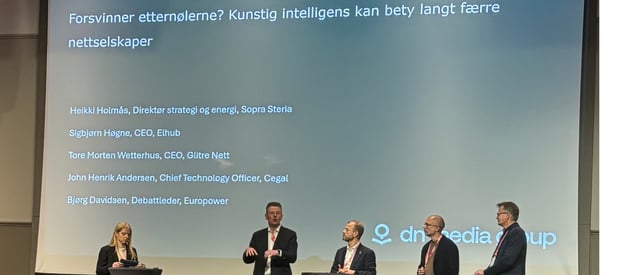The energy industry's IT conference 2025: Digital transformation in focus
The Energy Industry IT Conference 2025 (EuroPower) at the SAS Hotel in Oslo on October 22 once again brought together the industry's key players for a day filled with professional insight, discussion and inspiration. For Cegal, this has been an important meeting place for four years and this year's theme hit right at the core of what we work with every day: the deep digital transformation the energy industry is in the middle of.
This year's agenda was characterized by:
- the need for new technology
- increased efficiency
- an increasingly strict security regime.
Innovation and lessons from the financial industry
The conference opened with an inspiring strategic perspective from Rune Bjerke, former CEO/Chairman of Hafslund, DNB and Vipps.He shared valuable insights on innovation and drew clear parallels between the digital transformation that has taken place in the banking industry - through the Vipps journey, among others - and the challenges the energy industry now faces.
Bjerke's message was clear: the ability to innovate digitally is crucial for competitiveness, and the energy industry is facing many of the same shifts as the financial sector did a few years ago.
Geopolitical risk and data strategy
One of the most serious but important topics of the conference was the new threat landscape.
In thepanel debate "The world is suddenly much more unsafe", executives from Google, Hafslund, Tensio and Twoday discussed the industry's vulnerability in a geopolitical context.
A key question was whether Norwegian energy companies have a clear "exit strategy" if the use of American cloud services - such as Microsoft and Google - were to be challenged by new laws or international conflicts.
Several pointed out that the assessments made now are completely different to those made just three years ago.
AI as a driver for consolidation
One of the most engaging sessions of the day was the panel discussion "Are the laggards disappearing? Artificial intelligence can mean far fewer grid companies", in which John Henrik Andersen (CTO of Cegal) participated together with senior managers from Elhub and Glitre Nett.
The discussion focused on how artificial intelligence can be a catalyst for consolidation in the energy industry.
Major differences in technological capacity were highlighted - for example, how many people work with IT in companies like Elvia and Linea.
While consolidation seems inevitable, it was emphasized that the pace needs to be right and that the change would come anyway - AI only accelerates the process.
The new market reality: 15-minute resolution
The transition to 15-minute resolution in the power and balancing markets (mFRR) was a key theme throughout the conference.
Statnett described the change as "a whole new world" and rightly so.
The implications for the entire ecosystem are extensive:
- Data requirements: Metering data must be available, validated and reported much faster than before.
- IT providers: Systems must be rebuilt to handle at least four times as much data - in real time.
- Workflow: Many manual tasks in utilities and manufacturing must now be automated.
The change marks a clear shift towards a more data-driven and automated energy sector.
Lessons from the oil and gas industry
Another highlight was the presentation from Øystein Håland (Offshore Norway), who shared how the oil and gas industry on the Norwegian continental shelf has succeeded with standardization and common digital industry solutions.
He posed the question: Can the power industry do the same?
Platforms such as Collabor8 - which Statkraft is currently considering for the hydropower sector - were highlighted as possible solutions for increased collaboration and efficiency.
In the panel debate that followed, Nikolai Lyngø, former CEO of Sval Energi, among others, shared his reflections on what it takes to improve competitiveness.
An important point was the importance of choosing suppliers with ambitions that extend beyond the Norwegian market.
Cyber security and protection of critical infrastructure
Securing critical infrastructure was a recurring theme throughout the day.
In the panel on cybersecurity, Sofie Nystrøm from Fortified Tech shared concrete examples of how hacker attacks on power plants and operational technology happen today - including recent cases from Poland.
The message was clear: the threat landscape is changing rapidly, and digital security must be an integral part of operations, not an add-on.
Technology Optimist of the Year
An inspiring end to the day was the awarding of Jørgen Tjersland from Elbits as "Technology Optimist of the Year".
The award had an extra historical touch - the Elbits initiative was launched at the Technology Optimists conference four years ago.
Tjersland was honored for his tireless efforts to lift the industry and for his work in helping utilities across the country to implement TILKO.
A look ahead
The Energy Industry IT Conference 2025 clearly demonstrated that we are in the midst of an era of great change - technologically, geopolitically and structurally.
For us at Cegal, it's inspiring to be part of this journey and to contribute to a safer, more efficient and sustainable energy sector.